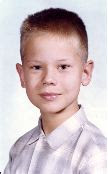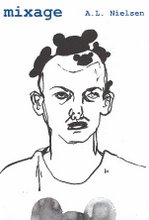I don't really know enough about string theory to be able to offer readers a clear explanation of the implausibly intersecting parallel universes Michael Bérubé and I inhabit. Visitors to the second floor of Burrowes Hall at Penn State University have noted that I appear to be the more tightly wound string, while there is observably greater gravity (and several more dimensions) at his end of the corridor. This has produced any number of strange effects in the years since we both arrived at Penn state, most notably the inexplicable disappearance of people who pause at the T intersection of our hallway while trying to figure out just where the department of Spanish might be.
All of which has to do with why I wasn't at the talk by Walter Benn Michaels, sponsored by Phi Beta Kappa, which Michael discusses over at his estimable blog, which commentary you can locate by clicking on his name right there on the right wing of my blog. (OK, my left -- I guess it is a matter of standpoint after all.) Several people on campus have wondered about this. I did, after all, attend and comment upon visits by David Horowitz and Dinesh D'Souza. I was out of town when Fred Jameson was here. Is there something about Benn Michaels that kept me away?
Well, yes -- there is -- but the real reason I didn't attend was a matter of Walter's personal safety, which gets us back to that weird parallel universe thing and the vanishing visitors to the Spanish department. The thing of it is, if Michael Bérubé and I were to attend the same talk by Walter Benn Michaels, so the theory goes (and Walter, you will recall, is against theory), there is a real possibility that the space-time continuum would warp so drastically that a wormhole would open up beneath the podium, sucking Walter through the 17th dimension and reproducing him in the office of the President of George Washington University, in essence, dumping him in the lap of Steven Knapp. This would not be good for Walter's molecular structure, though it would surely get some news coverage for Penn State.
This whole parallel universe thing seems to have started one day in 1969. I had just finished reading CONFRONTATION AT OCEAN-HILL BROWNSVILLE, edited by Maurice Bérubé and Marilyn Gittell. The struggles documented in that book had been much in the news as I was making my way through my own public schooling. Indeed, it virtually coincided with my High School years, and so it was a book I read with real interest as a snapshot of the times I was living in. But it seems I was living in more times (?) than I had realized. Immediately after putting down the Bérubé and Gittell book, I picked up a Twayne volume. (This, too, was to have a strange resonance in discussions at Penn State many years later, but that's a story for another blog.) The book was titled HARLEM GALLERY: Book 1: The Curator. I'd picked this book up because I'd heard of its author, poet Melvin B. Tolson, or "M.B. Tolson" as he'd been introduced at the Library of Congress just as I was completing Junior High School. There had been a little item in one of the local papers in Washington, D.C., noting the visit of Tolson to D.C., a visit that was occasioned by his reading at the Library of Congress and a quick visit to the Lyndon Johnson White House. Johnson's connections to poetry aren't much spoken of, but the one time I'd seen that president up close was when he showed up unexpectedly at a memorial for Carl Sandburg held on the steps of the Lincoln Memorial. Anyway, I had been wanting to read Tolson ever since seeing that note, and now that I was out of high school and employed, I could purchase my own copy of HARLEM GALLERY.
But here's the thing; as I read Tolson's book, I kept having this eerie feeling that it was somehow connected to what I had just been reading about Ocean-Hill Brownsville (a neighborhood that James Baldwin had also written about much earlier). -- OR, more accurately, I had the feeling that the Tolson poems would SOME DAY find a connection to the Bérubé & Gittell book.
I didn't think much more about that for some time, what with college and my draft board and actually getting drafted to distract me from such things -- but some years later and far away in Charlottesville, Virginia, it all came rushing back to me.
I'd driven down from D.C. with my good friend Ross Taylor, who was going to visit his father, Peter. Peter Taylor, so far as I could tell, was busy on a life-long project to renovate and live in every house in the Shenandoah Valley. Somehow, in the midst of all that, he found time to knock out books like A SUMMONS TO MEMPHIS, THE OLD FOREST, A WOMAN OF MEANS and others. It made me wonder if Ross's father had a busy doppelganger or himself traveled wormholes to different dimensions of time and literature.
So, there I am sitting in a cafe in Charlotesville, listening to Ross read me a poem about cows and telephone poles, when my eyes drifted up over Ross's shoulder and out the window of the cafe. Into my line of sight walked a youngish fellow with really curly hair clutching, for some reason, three drumsticks. It wasn't the odd number of drumsticks that arrested my attention, though, it was the fact that I could see peeping out of his jacket pocket a paperback copy of Melvin B. Tolson's LIBRETTO FOR THE REPUBLIC OF LIBERIA. "That's unusual," I caught myself saying out loud. "Not at all," Ross replied. "I saw that happen to a cow once up the road from my father's third house." I didn't set Ross straight on my frame of reference. I just sat there wondering why I felt like I'd been there before, or like I would have been there before, had there been a there in Charlottesville.
I've since come to understand that there is a lot of strange physics in the Tolson universe (just ask Jon Woodson), which is why nobody has ever been allowed to hold a Tolson conference anywhere, though Denzel Washington, who works out there in the land of particle accelerators, hopes to make a Tolson movie. Still, convergence happens. Which is how Penn State, entirely without knowing that it was doing so, became the only university in the world to host two Tolson scholars in the same department -- and that's why there's this peculiar space-time warp in Burrowes Hall that even requires that visitors walk up a flight of stairs to get from the second floor to the second floor.
And, as I've said, this is why I thought it unwise that both Micheal and I should attend Walter Benn Michaels's talk -- It was going to be trouble enough with Michael confronting Benn Michaels --
Still, I confess to some surprise when I read Michael's subsequent blog entry and learned that the people organizing Walter's visit had emailed Michael to ask about a possible class visit. As Michael points out in his blog, it was a bit of a stretch, since the email indicated that they were looking for a class in American Literature through 1940, and his course concerns American fiction since 1945. I, however, was teaching a course in American fiction before 1940, and didn't hear from anybody about any possible class visit. I was, to be specific, teaching the first half of the African American novel course. Now, I suppose it's possible that someone thought my course wasn't the best place for a man to visit who had just published a book titled THE TROUBLE WITH DIVERSITY, but, as it happens, the subject of our class discussion that very morning was Nella Larsen's novel QUICKSAND, of which, to judge from Walter's book OUR AMERICA, he has read every second sentence.
In OUR AMERICA, a book in which Walter expresses certain misgivings about race, multiculturalism, diversity and any number of other scholars, there are several passages in which Walter worries the way that the protagonist of Larsen's first novel exhibits, in his view, an attachment to "the fact of race itself." This is especially evident, he holds, in the sections of the novel that narrate Helga Crane's time in Denmark. (As Penn State's only Danish-American literary critic, I feel compelled to teach the work of America's foremost Afro-Danish-American novelist as often as possible, for reasons that Benn Michaels would reject.) Walter says that in Denmark, "Helga herself becomes the enforcer of racial identity on the American plan." Of course, that phrase "on the American plan" is sufficiently elastic as to form a space-time warp and avenue of escape itself for Walter's argument, but what's striking in this formulation is the way in which Walter elides nearly all the passages in which Larsen's text shows that the Danes are themselves able purveyors of race. It is, for instance, in Copenhagen that Helga sees the Minstrel performance that grips her so. Everywhere Helga goes, she hears the Danish word for "black" being whispered around her. It is Fru Dahl who, contradicting the Dean of Women at Naxos earlier in the novel, insists that Helga should wear bright things, "striking things, exotic things." And even when Walter quotes from the text, he only reads a part of the relevant passage. Hoping to demonstrate that it is Helga who is the enforcer of race, Walter says that she disdains her Danish aunt's "arguments that such prohibitions [as interracial marriage] are not to be taken seriously 'in connection with individuals.'" A close reader might already feel a certain dissonance between Walter's argument and that orphan phrase he quotes. But what the aunt actually says to Helga is: "We don't think of those things here. Not in connection with individuals, at least." You can practically hear some southerner protesting, "but some of my best friends are colored." How Walter manages to elide the ironies Larsen gives us with that "at least" is beyond comprehension.
But it's a trick with a quote that he performs often. Elsewhere in OUR AMERICA he discusses Stephen Vincent Benét's JOHN BROWN'S BODY, a staged version of which I once attended at Ford's Theater on a night when nobody got shot. Walter writes that "Benét's essentially pluralistic nationalism commits him more truly to denying that he can represent the Negro at all than to representing him well." There is a footnote attached at this point, and, since I work in a university that requires me to find citations to myself, I note that this footnote leads to my own first book. Walter's note, having identified READING RACE (thanks, Walter -- my university only counts citations -- it doesn't seem to matter whether they are positive or negative), Walter goes on to comment: "Aldon Lynn Nielsen praises Benét for precisely this refusal, saying that 'he saw more plainly than many the dangers attendant upon attempting to appropriate the voice of the other.' The sanctity of otherness is, of course, fundamental to racial pluralism."
Goodness gracious, as our recently departed Secretary of Defense often said. Those few who have actually read my book know that it contains not one word proposing the sanctity of otherness, and I am a life-long opponent of the essentialist essence of cultural pluralism. What Walter is doing, not at all slyly, is conflating two senses of the word "representation." Benét never forgoes an opportunity to represent black subjects in the sense of speaking ABOUT them. There are many of them in JOHN BROWN'S BODY -- Their appearance, of course, is exactly what I talk about in READING RACE. What Benét refuses is representation in the sense of speaking FOR, as opposed to speaking about. Walter accuses his "chuckle-headed multi-culturalists," to borrow a coinage from Eric Lott, of regarding black Americans as the unrepresentable, irreducible racial other. Not even Benét finds African Americans unrepresentable, though it might be better, given the stereotypes found in his work, if he had. What he refused to do, and I still believe this represents some modicum of progress, was to wholly supplant the self-representations of black Americans. He writes that he cannot write the black-skinned epic -- that such a project awaits a black poet -- It may well be that Benét had never heard of poets such as Alberry Whitman, who had undertaken just such projects. It is certainly the case, though, that one Melvin B. Tolson read Benét, and was determined to supply the epic.
Michael Eric Dyson once came up to me after a talk and enthusiastically congratulated me on the way that I had been "representing." See there, Walter -- I have no fear of representing -- I have no problem, am doing it right now, talking ABOUT Michael Eric Dyson. I have no problem explaining what I take Michael Eric Dyson to be saying. I do draw the line at speaking in his place, at ventriloquising him. That does not make me a worshiper in the sanctum of racial otherness.
On the other hand, I have a big problem with scholars representing the works of others in so loose and careless a fashion as typified by Benn Michaels.
Now, what do you suppose would happen to the space-time continuum if Michael Bérubé, Walter Benn Michaels and Michael Eric Dyson appeared in the same room?
Subscribe to:
Post Comments (Atom)




















1 comment:
Thanks for the laugh and good insights!
Post a Comment